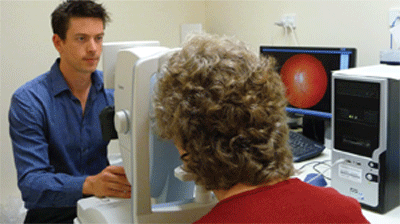Retina imaging, along with other biomarker tests, may be able to aid in early detection of Alzheimer’s disease (AD), according to a study presented at the Alzheimer’s Association International Conference in July.1

Shaun Frost, M.Sc., taking retinal images of a patient to look for early signs of Alzheimer’s disease.
Specifically, the width of retinal blood vessels are significantly different for people with AD vs. healthy controls, according to Shaun Frost, M.Sc., and colleagues from Australia’s Commonwealth Scientific and Industrial Research Organization.
“The changes to the retina in AD are very subtle and not discernable from simple viewing—it takes sophisticated software to detect,” says Mr. Frost. The researchers noted that this change correlated with the deposition of amyloid plaques in the brain (as measured by PET PiB imaging), a benchmark indicative of Alzheimer’s disease.
Only one previous report from a smaller study has found retinal vascular changes in AD.2 “Our study was novel in that it explored these changes with respect to plaque build-up in the brain—the earliest sign we have of the disease,” Mr. Frost says. “The relationship we found is encouraging for the future use of an eye test as part of a simple, early test to screen for AD.”
1. Frost S, Martins RN, Kanagasingam. Retinal vascular parameters as biomarkers for Alzheimer’s disease. AAIC 2011; Abstract P1-081.
2. Berisha F, Feke GT, Trempe CL, et al. Retinal abnormalities in early Alzheimer’s disease. Invest Ophthalmol Vis Sci. 2007 May;48(5):2285-9.

